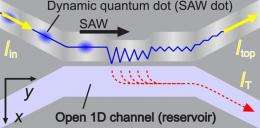May 6, 2009 feature
Physicists Detect Single-Electron Tunneling with Quantum Dots

(PhysOrg.com) -- Detecting the coherent motion of a single electron is a challenge, for the simple reason of scale: the timescale of the coherent motion of a single-electron wave function is in the picosecond regime (one trillionth of a second), which presents significant technical difficulties. However, understanding single-electron dynamics is very important for a wide range of future quantum technologies.
Recently, a team of scientists from the University of Cambridge’s Cavendish Laboratory and the Toshiba Research Europe Limited, both in Cambridge, as well as the University of Strathclyde in Glasgow, have designed an experiment that allows for the observation of single-electron tunneling at the picosecond timescale. In their technique, moving quantum dots that contain single electrons travel through a circuit with regions of different confinement, which excites the electrons into a superposition of states and causes them to oscillate. The physicists could detect oscillations in the resulting current, overcoming many of the challenges in single-electron detection. Their study is published in a recent issue of Physical Review Letters.
"For the first time, we have detected the coherent motion of a single electron within a quantum dot," lead author Masaya Kataoka told PhysOrg.com. Kataoka was previously with the University of Cambridge, and is now with the National Physical Laboratory in London.
Previously, most approaches to electron detection have involved the application of short pulses to the electrodes of the experimental device. By arranging their device a bit differently, the UK team could avoid the need for these pulses. In their setup, they work with quantum dots, with each containing just one electron. The quantum dots travel at a velocity of about 2,800 meters per second through a channel past a tunnel barrier, on the other side of which is a parallel channel.
“Because of the bandwidth limitation, past observations of coherent motion of single electrons were done using a relatively slow process, such as oscillation between two quantum dots,” Kataoka said. “The motion of an electron within a quantum dot, at a single-electron level, is normally much faster. It is not easy to fabricate a single-electron quantum dot, or a quantum dot suitable for high-frequency measurement. Our idea of moving quantum dots through a circuit, rather than using a static quantum dot, seems to work for this purpose.”
The new method is based on the fact that the ground state of an electron in a quantum dot is very fragile, and a sudden change in the confinement potential can excite the electron from the ground state to a superposition of eigenstates. A short tunnel barrier provides just such a change in confinement to produce a superposition. If an electron encounters this tunnel barrier, it achieves a superposition of states, oscillating with a period of about 5 picoseconds and at a frequency that depends on the energy gap between the states.
In the setup, an electron wave function oscillates from side to side in the channel, periodically hitting the short tunnel barrier. At the weakest point of the tunnel barrier, an electron can tunnel into a parallel channel and escape into a different exit than the exit at which the electrons that don’t tunnel go to. In other words, the electron oscillations lead to oscillations in the tunnel current, and the physicists could detect the tunnel current oscillations by making a weak, repeated measurement of the current at the second exit. Unlike many previous experiments, this technique doesn’t require the application of short pulses, enabling it to overcome bandwidth limitations.
“Basically, the success of our experiments depended on giving each electron a chance to tunnel out for a very short time, on the order of 100 picoseconds or less,” Kataoka said.
This new experimental technique could not only increase the understanding of electron dynamics on a fundamental level, but also assist in the development of future technologies that involve quantum mechanical dynamics, such as quantum electronics, quantum optics, and quantum information processing. For instance, the basis of a qubit for many quantum computation schemes is the charge state or spin state of a single electron trapped in a quantum dot. Compared with quantum dots that contain multiple electrons, quantum dots that contain single electrons provide stronger confinement potential, which leads to a faster dynamic process.
“The capability of detecting coherent motion of electrons opens up various possibilities,” Kataoka said. “Quantum computation requires fast manipulation and measurement of quantum states. Our technique of creating a short tunnel barrier may be used for such operations. Also, unlike many other solid-state quantum computation schemes, our quantum systems move through circuits. This can provide an ‘information bus’ that carries quantum information between static quantum systems. Another idea would be that we may be able to construct an experimental setup similar to quantum optics, replacing noninteracting bosons (photons) with interacting fermions (electrons), by channeling electrons through a series of circuits and tracking their coherent motions.”
More information: M. Kataoka, et al. “Coherent Time Evolution of a Single-Electron Wave Function.” Physical Review Letters 102, 156801 (2009).
Copyright 2009 PhysOrg.com.
All rights reserved. This material may not be published, broadcast, rewritten or redistributed in whole or part without the express written permission of PhysOrg.com.
















